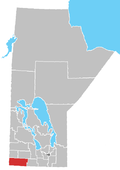Rural municipality in Manitoba, Canada
| Grassland | |
|---|---|
| Rural municipality | |
| Municipality of Grassland | |
 Location of the Municipality of Grassland in Manitoba Location of the Municipality of Grassland in Manitoba | |
| Coordinates: 49°25′52″N 100°18′36″W / 49.431°N 100.310°W / 49.431; -100.310 | |
| Country | Canada |
| Province | Manitoba |
| Region | Westman |
| Incorporated (amalgamated) | January 1, 2015 |
| Area | |
| • Total | 1,350.34 km (521.37 sq mi) |
| Population | |
| • Total | 1,583 |
| • Density | 1.2/km (3.0/sq mi) |
| Time zone | UTC-6 (CST) |
| • Summer (DST) | UTC-5 (CDT) |
The Municipality of Grassland is a rural municipality (RM) in the Canadian province of Manitoba.
History
Further information: Rural Municipality of Cameron; Rural Municipality of Whitewater; and Hartney, ManitobaThe RM was incorporated on January 1, 2015 via the amalgamation of the RMs of Cameron and Whitewater and the town of Hartney. It was formed as a requirement of The Municipal Amalgamations Act, which required that municipalities with a population less than 1,000 amalgamate with one or more neighbouring municipalities by 2015. The Government of Manitoba initiated these amalgamations in order for municipalities to meet the 1997 minimum population requirement of 1,000 to incorporate a municipality.
Communities
Demographics
In the 2021 Census of Population conducted by Statistics Canada, Grassland had a population of 1,583 living in 552 of its 617 total private dwellings, a change of 1.4% from its 2016 population of 1,561. With a land area of 1,350.34 km (521.37 sq mi), it had a population density of 1.2/km (3.0/sq mi) in 2021.
Lauder Sand Hills
The Lauder Sand Hills (49°29′0″N, 100°39′56″W) are located 6 kilometres west of Hartney, were created between 10,000 and 8,000 years ago when the glaciers from the last ice age receded to the north. The glaciers left huge lakes in their wake and the lake that was responsible for the sand hills was named Glacial Lake Hind. The sand hills were formed by sand deposits left behind by a river delta going into the lake. When the lake eventually drained away, the Lauder Sand Hills were left behind. In 1971, the Lauder Sandhills Wildlife Management Area was established to protect the winter habitat of the white-tailed deer. The management area covers 3,145 hectares of land.
Lauder Sand Hills, Oak Lake, Oak Lake Marsh, Maple Lake, and Plum Lakes are all part of an Important Bird Area (IBA) of Canada called Oak Lake / Plum Lakes Area (MB 011). This IBA is a very important breeding ground and stop-over for migrating birds and it covers 654.07 km (252.54 sq mi) of habitat.
References
- ^ "The Municipal Amalgamations Act (C.C.S.M. c. M235): Rural Municipality of Cameron, Town of Hartney and Rural Municipality of Whitewater Amalgamation Regulation" (PDF). Government of Manitoba. Retrieved October 4, 2014.
- "The Municipal Amalgamations Act (C.C.S.M. c. M235)". Government of Manitoba. October 2, 2014. Retrieved October 4, 2014.
- "Speech from the Throne: At the Opening of the Second Session of the 40th Legislature of the Province of Manitoba". Government of Manitoba. November 19, 2012. Retrieved October 4, 2014.
- "Population and dwelling counts: Canada, provinces and territories, and census subdivisions (municipalities), Manitoba". Statistics Canada. February 9, 2022. Retrieved February 20, 2022.
- Government of Canada, Natural Resources Canada. "Place names - Lauder Sand Hills". www4.rncan.gc.ca.
- "Municipality of Grassland - Lauder Sandhills".
- "Lauder Sandhills | Turtle Mountain–Souris Plains Heritage Association".
- "Oak Lake/Plum Lakes Area (MB011)". ibacanada. Hosted by Bird Studies Canada. Retrieved November 2, 2021.
- "Important Bird and Biodiversity Areas in Canada". IBA Canada. Birds Canada. Retrieved November 2, 2021.
| Places adjacent to Municipality of Grassland | |
|---|---|
| Division No. 5, Manitoba (Southwest Manitoba) | ||||
|---|---|---|---|---|
| Towns |
|  | ||
| Villages |
| |||
| Rural municipalities |
| |||
| Unincorporated communities | ||||